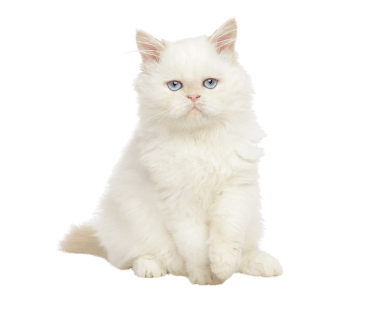Persian
About the Breed
Few would deny that the luxurious, flowing coat of a Persian has symbolized feline beauty at its peak for well over 100 years. But it’s not just about the coat. Judges and experienced exhibitors know that the structure beneath that breathtaking fur is all-important. It must be symmetrical, substantial, refined, and above all—ROUND. The cat’s eyes, head, muzzle, body, even the ear tips, all convey the impression of a circle, with those huge, round eyes precisely located in the center of the face, and gazing up at you with an expression that is the epitome of sweetness. It’s a look that practically no one can resist.
Breed History
While the Persian’s name comes from its presumed country of origin, we don’t know precisely how it arrived in western Europe. However, in 1626, Pietro della Valle, an Italian trader, returned from a trip to Persia with an impressive, heavily-coated longhaired cat that was distinctly different from the Turkish Angora, which had reached Europe at about the same time. The two breeds were combined in order to produce a sturdy, short-nosed cat with a coat that was silky in texture, yet dense and full of body. When cat shows began in the early 1900s, these selectively bred Persians became the dominant breed. The first imports into the U.S. arrived in the late 1880s; Persians contributed to the formation of the cat fancy throughout the English-speaking world and were one of the six foundation breeds established by the Cat Fanciers’ Association at its start in 1906.
Persian Cat Breed Standard
Balance and refinement are the essence of the breed, where all parts come together in a harmonious whole, with neither too much nor too little consideration given to any one feature.
For cats in the tabby division, the 20 points for color are to be divided 10 for markings and 10 for color. For cats in the bi-color division, the 20 points for color are to be divided 10 for “with white” pattern and 10 for color.
GENERAL:
The ideal Persian should present an impression of a heavily boned, well-balanced cat with a sweet expression and soft, round lines. The large round eyes set wide apart in a large round head contribute to the overall look and expression. The long thick coat softens the lines of the cat and accentuates the roundness in appearance.
HEAD:
Round and massive, with great breadth of skull. Round face with round underlying bone structure. Well set on a short, thick neck. Skull structure to be smooth and round to the touch and not unduly exaggerated from where the forehead begins at the top of the break to the back of the head, as well as across the breadth between the ears. When viewed in profile, the prominence of the eyes is apparent and the forehead, nose, and chin appear to be in vertical alignment.
NOSE:
Short, snub, and broad, with “break” centered between the eyes.
CHEEKS:
Full. Muzzle not overly pronounced, smoothing nicely into the cheeks.
JAWS:
Broad and powerful.
CHIN:
Full, well-developed, and firmly rounded, reflecting a proper bite.
EARS:
Small, round tipped, tilted forward, and not unduly open at the base. Set far apart, and low on the head, fitting into (without distorting) the rounded contour of the head.
EYES:
Brilliant in color, large, round, and full. Set level and far apart, giving a sweet expression to the face.
BODY:
Of cobby type, low on the legs, broad and deep through the chest, equally massive across the shoulders and rump, with a well-rounded mid-section and level back. Good muscle tone with no evidence of obesity. Medium to large in size. Quality the determining consideration rather than size.
LEGS:
Short, thick, and strong. Forelegs straight. Hind legs are straight when viewed from behind.
PAWS:
Large, round, and firm. Toes carried close, five in front and four behind.
TAIL:
Short, but in proportion to body length. Carried without a curve and at an angle lower than the back.
COAT:
Long and thick, standing off from the body. Of fine texture, glossy and full of life. Long all over the body, including the shoulders. The ruff immense and continuing in a deep frill between the front legs. Ear and toe tufts long. Brush very full.
TRANSFER TO AOV:
Cats not accepted for championship status.
DISQUALIFY:
Locket or button. Kinked or abnormal tail. Incorrect number of toes. Any apparent weakness in the hindquarters. Any apparent asymmetry of the face/head. “Cow-hocked” legs, resulting in an asymmetrical face and/or head. Nose that is visibly set to one side of the vertical line of the forehead. Crossed eyes.
“The above listed disqualifications apply to all Persian cats. Additional disqualifications are listed under ‘Colors.’”
WHITE: pure glistening white. Nose leather and paw pads: pink. Eye color: deep blue or brilliant copper. Odd-eyed whites shall have one blue and one copper eye with equal color depth.
BLUE: blue, lighter shade preferred, one level tone from nose to tip of tail. Sound to the roots. A sound darker shade is more acceptable than an unsound lighter shade. Nose leather and paw pads: blue. Eye color: brilliant copper.
BLACK: dense coal black, sound from roots to tip of fur. Free from any tinge of rust on tips or smoke undercoat. Nose leather: black. Paw pads: black or brown. Eye color: brilliant copper.
RED: deep, rich, clear, brilliant red; without shading, markings, or ticking. Lips and chin the same color as coat. Nose leather and paw pads: brick red. Eye color: brilliant copper.
CREAM: one level shade of buff cream, without markings. Sound to the roots. Lighter shades preferred. Nose leather and paw pads: pink. Eye color: brilliant copper.
CHOCOLATE: rich, warm chocolate-brown, sound from roots to tip of fur. Nose leather: brown. Paw pads: cinnamon-pink. Eye color: brilliant copper.
LILAC: rich, warm lavender with a pinkish tone, sound and even throughout. Nose leather: lavender. Paw pads: pink. Eye color: brilliant copper.




